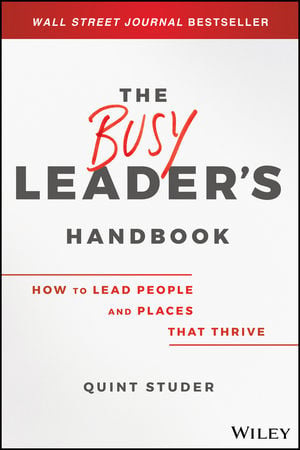
Embracing discomfort: Why allowing yourself to be unsettled makes you a better leader
Self-disruption in business is uncomfortable but necessary, says Quint Studer. These tips help leaders get comfortable with discomfort and do what’s right for their business
Disruption is inevitable in business. Marketplaces shift. Customer needs evolve. New technology emerges. Employees come and go. Quint Studer says it’s far better for your company to disrupt itself than to let the marketplace force changes on you. If you wait and a competitor takes all the business, it will be too late. Being proactive, not reactive, will let you strategize and better control the process. There’s just one problem: Self-disruption is really uncomfortable.
“Over the years, as I have interacted with many individuals and groups, I have recommended various actions that, if implemented, would improve performance and lead to better results,” says Quint Studer, author of the Wall Street Journal bestseller The Busy Leader’s Handbook: How to Lead People and Places That Thrive (Wiley, October 2019, ISBN: 978-1-119-57664-8, $28.00). “Quite often, I get pushback. A common response is, ‘I am not comfortable doing that.’ But much of a leader’s job is spent being uncomfortable and leading others through discomfort as well.”
A good example of self-disruption is finding ways to differentiate yourself from competitors. Studer says this can feel uncomfortable to people.
“I often suggest letting customers or clients know your training and experience up front,” says Studer. “Think of a scenario in which a chef comes out, introduces themselves, and reviews the dinner options. What if the chef added where they had gone to culinary school and also mentioned their other training and experience? This addition not only impresses the people hearing it, but informs them in a way that they can share it with others. This creates effective word of mouth.
“The pushback I sometimes receive is that saying these things sounds like ‘bragging,'” he adds. “My response is, ‘No, it creates a feeling of confidence in the customer.’ Check the information on a poster advertising a concert, a play, or a performer. You’ll see that well-known, positive things are shared (e.g., if the performer is a winner of a Tony Award on Broadway or how many top-40 hits they have). There is nothing wrong with letting people know you are well qualified and good at doing your job.”
Yes, taking actions that make us uncomfortable is hard. Taking actions that create discomfort in others is just as hard or even harder. Yet that is part of the leader’s job. If we are to do our job right, it’s inescapable. Here are some tips for handling the “unsettling” that you will experience as a leader and cause others to experience.
Realize that discomfort is normal. As M. Scott Peck wrote in his book The Road Less Traveled, “Life is difficult…Once we truly know that life is difficult—once we truly understand and accept it—then life is no longer difficult.”
It’s best if disruption comes from you and the organization and not from outside sources. Make time to work on the business, not just in the business. Reevaluate your company regularly. Schedule a time to pick apart your processes and systems. Keep that date, no matter what. Take it one department at a time. You are likely to find what you think is happening inside your company—perhaps even the very basic fundamentals—isn’t happening. This will give you a chance to step in and make needed changes—to disrupt yourself.
Get in the habit of asking questions. Regularly ask employees what they think your biggest challenges are. What might the company do differently? What is holding us back? What is working well? (This may be the most important one of all, and, in fact, you should lead with it.) Also, question customers on how you can better serve them, when and where you’ve exceeded expectations, and what problems you solve for them. Never be afraid to ask questions for fear you might not like the answers. If you don’t ask, you won’t know what you need to improve.
Own the messages that unsettle you and others. It is easy to blame someone else. Saying to the staff that you don’t like it either, but it is the corporate position, impacts the company poorly. Let’s say the yearly budget you are given is less than you had asked for. It will mean letting the staff know that more help will not be hired or a new piece of equipment will not be bought. As a leader, you have a choice: You can deflect the pressure (and ease the discomfort you feel) by blaming corporate, or you can carry the message yourself. Those who carry the message themselves and take ownership of it are the real leaders.
“Don’t be afraid to ask corporate to explain something further so you can better understand the decision and explain it to your staff,” says Studer. “It will still be uncomfortable, but it is the way a good manager handles things.”
Understand and explain the why. “I went to a dermatologist about a spot on my face,” says Studer. “The physician looked it over, took a small sample, sent it to pathology, and asked me to wait for the results. About 30 minutes later, he told me it was skin cancer and needed to come out. I then (nicely) asked him where he went to medical school and did his residency. He answered that he graduated from Vanderbilt University School of Medicine and completed both his residency and a fellowship in dermatology there.
“Was he bragging or self-promoting by telling me his background? No. He was reducing my anxiety and building my confidence as a patient. That’s the why. Once people understand the why behind what they’re being asked to do, they are almost always willing to push through the discomfort and adopt the behavior. As leaders it’s our job to convey the why in a way that people can truly hear and understand.”
Make it a cultural standard to immediately admit to mistakes. This is one of the most valuable things leaders and employees can do, because owning up to mistakes allows you to quickly fix issues and course correct. Yet the prospect of admitting mistakes is deeply unsettling to people. As a leader, model this behavior. Say, “I was wrong,” when needed. And make sure it’s psychologically “safe” for others to do so as well by not punishing mistakes. Make it clear that mistakes are a necessary part of learning and growth.
Urge employees to get in on the self-disruption, too. Once your employees see that you’re constantly evaluating how the company is doing, they’ll get involved, too. It won’t be just you, the business owner or leader, who is looking for ways to improve. It will be everyone working together. Those closest to the process (employees) are often the best ones to disrupt and improve it.
The beauty of regular self-disruption is that it creates a culture inside your company in which people continually look for a better way to do things—a culture in which no one is satisfied with anything less than the best. Creating this kind of culture is worth the uncomfortable feeling of being a little unsettled.
Don’t forget to recognize and celebrate what’s going right. As you constantly seek to disrupt and unsettle yourself, you will also find that some things are going right inside your company. This allows you to celebrate the “wins” with employees and also to praise and reward your high performers. This keeps engagement and morale high and encourages employees to work even harder and smarter.
Remember, discomfort is neither good nor bad. It’s a byproduct of change. It gets a bad rap at times, yet some change can be very good. That new baby, new job, new house, car, city, or even that new understanding—all of these are uncomfortable, because all mean an adjustment in some manner. Yet most people will ultimately agree that once the dust settles, the change was worth the temporary discomfort.
“Leadership means unsettling ourselves and others,” concludes Studer. “The most effective leaders realize that being unsettled is part of the process of life, and they work to understand and role model this truth.”
About the Author:
Quint Studer is the author of the Wall Street Journal bestseller The Busy Leader’s Handbook and a lifelong businessman, entrepreneur, and student of leadership. He not only teaches it; he has done it. He has worked with individuals at all levels and across a variety of industries to help them become better leaders and create high-performing organizations. He seeks always to simplify high-impact leader behaviors and tactics for others.
Quint has a great love for teaching his insights in books and has authored nine of them in addition to The Busy Leader’s Handbook. His book Results That Last also made the Wall Street Journal bestseller list. Building a Vibrant Community, published in 2018, is a blueprint for communities seeking to revitalize themselves.
Quint is the founder of Vibrant Community Partners and Pensacola’s Studer Community Institute. He currently serves as the Entrepreneur-in-Residence at the University of West Florida.
To learn more, please visit www.thebusyleadershandbook.com









